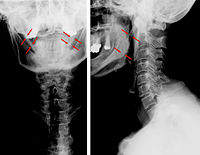
Photo from wikipedia
While silent sinus syndrome (SSS) is familiar to otolaryngologists and ophthalmologists, it is a rare clinical entity in dentistry and is likely to be underdiagnosed due to dentists' lack of… Click to show full abstract
While silent sinus syndrome (SSS) is familiar to otolaryngologists and ophthalmologists, it is a rare clinical entity in dentistry and is likely to be underdiagnosed due to dentists' lack of awareness of this condition. SSS presents a diagnostic challenge to dentists, as patients typically have no history of trauma or sinusitis. The characteristic feature of SSS is a gradual retreat of the maxillary sinus walls, resulting in enophthalmos and hypoglobus. Multidetector (multislice) computed tomography is the imaging modality of choice for SSS and other paranasal sinus diseases. Cone-beam computed tomography promises to be an alternative low-dose imaging modality. This report describes 3 cases of SSS in adults, who had no identified clinical symptoms except diminutive and opacified maxillary sinuses, as well as the inward bowing of the sinus walls as noted on cone-beam computed tomographic imaging.
Journal Title: Imaging Science in Dentistry
Year Published: 2020
Link to full text (if available)
Share on Social Media: Sign Up to like & get
recommendations!